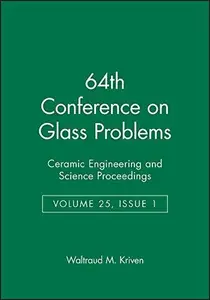
Free Download 64th Porcelain Enamel Institute Technical Forum: Ceramic Engineering and Science Proceedings, Volume 23, Issue 5 By
2002 | 203 Pages | ISBN: 0470294760 | PDF | 16 MB
This volume is part of the Ceramic Engineering and Science Proceeding (CESP) series. This series contains a collection of papers dealing with issues in both traditional ceramics (i.e., glass, whitewares, refractories, and porcelain enamel) and advanced ceramics. Topics covered in the area of advanced ceramic include bioceramics, nanomaterials, composites, solid oxide fuel cells, mechanical properties and structural design, advanced ceramic coatings, ceramic armor, porous ceramics, and more.Content: Chapter 1 Checklist for Fabrication (pages 1-9): Larry L. SteeleChapter 2 Experiences with Hydroforming (pages 11-14): Steve ChamplinChapter 3 Economizing Your Enamel Pretreatment (pages 15-22): Ken KaluznyChapter 4 Finite Element Analysis (pages 23-40): Bob YanceyChapter 5 Electrical Grounding of Target during Electrostatic Powder Porcelain Application (pages 41-44): Holger EveleChapter 6 A Standard Test Method for Measuring the Adherence of Porcelain Enamel Coatings to Sheet Metal (pages 45-49): George F. AltemusChapter 7 The Effects of Rubidium on Selected Electrostatic Powder Properties (pages 51-52): Steve KilczewskiChapter 8 A New Process of Direct Enameling on Various Steel Grades Coated with Special Electro?Deposited Nickel (pages 53-59): Fumiaki Sato, Yoshihiro Johno, Toshihira Hamada and Masao KomaiChapter 9 Recent Developments in Electronic Porcelain Enamels (pages 61-66): Charles A. Baldwin, William D. Faust and Rich GiardinaChapter 10 Laser Marking Materials (pages 67-76): David SmithChapter 11 The Worldwide Appliance Industry: Statistics, Trends, and Challenges (pages 77-82): Linda Abu?ShalbackChapter 12 Keeping the World in Hot Water: A Look at the Water Heater Industry, Past, Present, and Future (pages 83-90): James RodenChapter 13 Rheology Study of Ceramic Glaze (pages 91-109): Glenn StephensonChapter 14 Water Effects on Porcelain Enamel Rheology (pages 111-114): Richard Kmoch and Scott LevyChapter 15 Viscosity as a Measure to Control Enamel Application (pages 115-121): Holger EveleChapter 16 Electrolyte Interactions in Porcelain Enamel Slips (pages 123-129): Peggy L. DamewoodChapter 17 Cast Iron Blasting Machine (page 131): Liam O’Byrne and Rick RushChapter 18 Humidity Measurement (pages 133-151): Harry J. TrainorChapter 19 Dehumidification Drying (pages 153-170): Kevin CoursinChapter 20 Powder Spraygun Performance Compensation (pages 171-177): Tom MattheyChapter 21 PEI Environmental Activities: Metal Products and Machinery Effluent Limitation Guidelines and Other Rules (pages 179-187): Jack WaggenerChapter 22 Safety Report (pages 189-196): James J. CarletonChapter 23 2002 PEI Technical Affairs Committee Report (pages 197-201): Jeff WrightChapter 24 The State of PEI: Prepared for 2002 and Beyond (pages 203-206): Cullen Hackler
